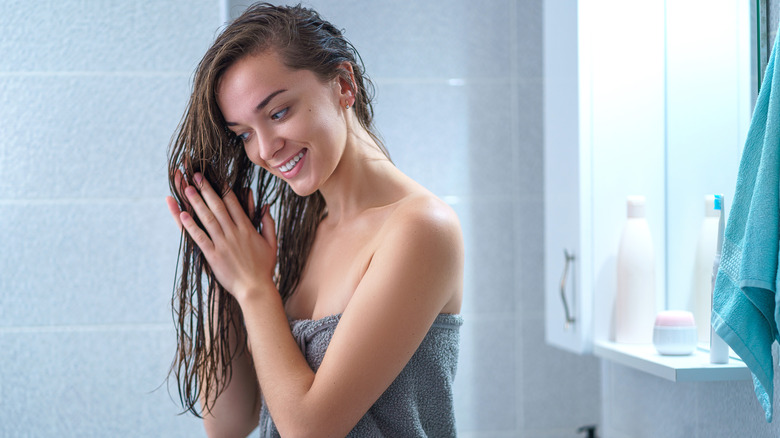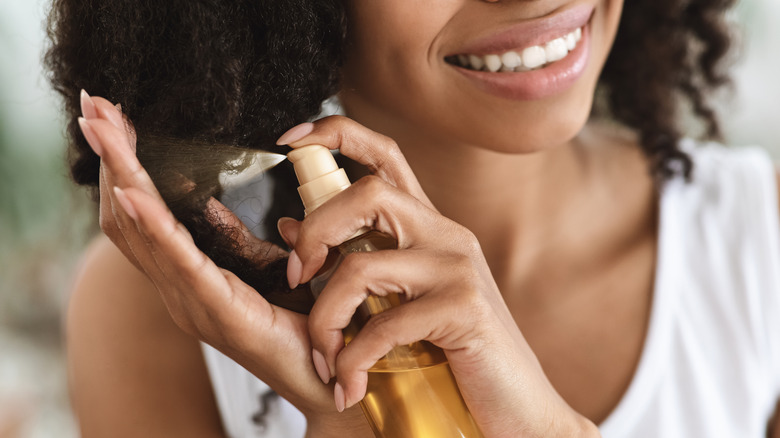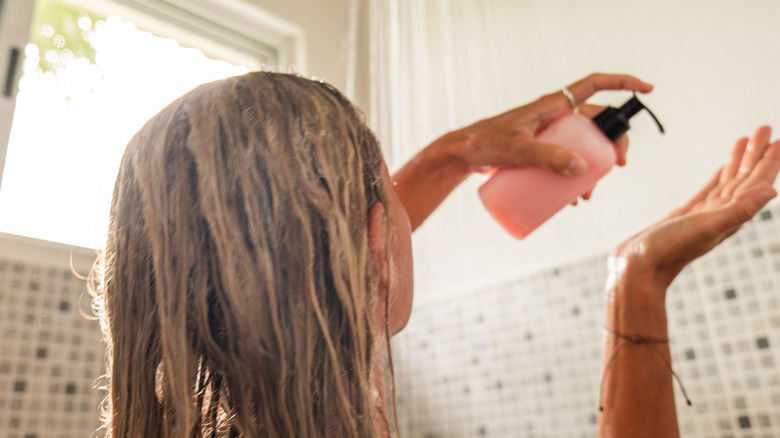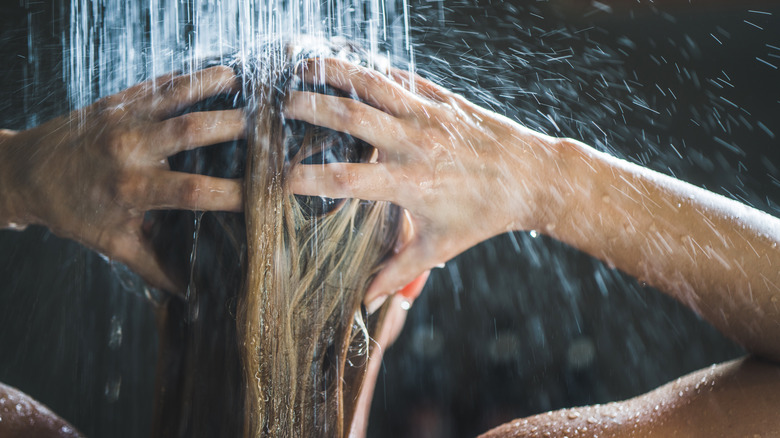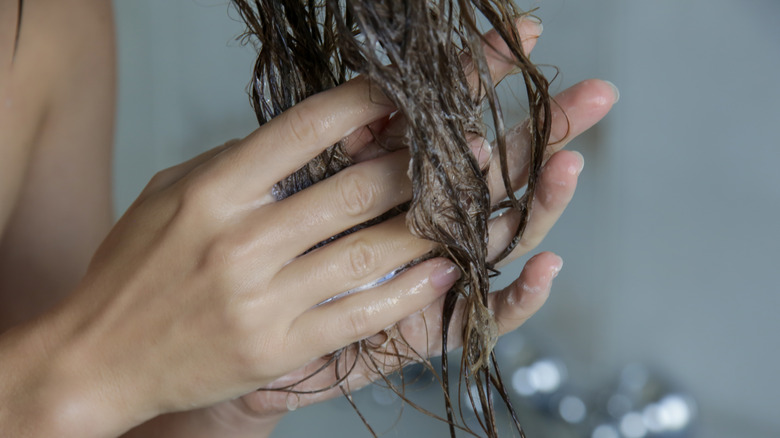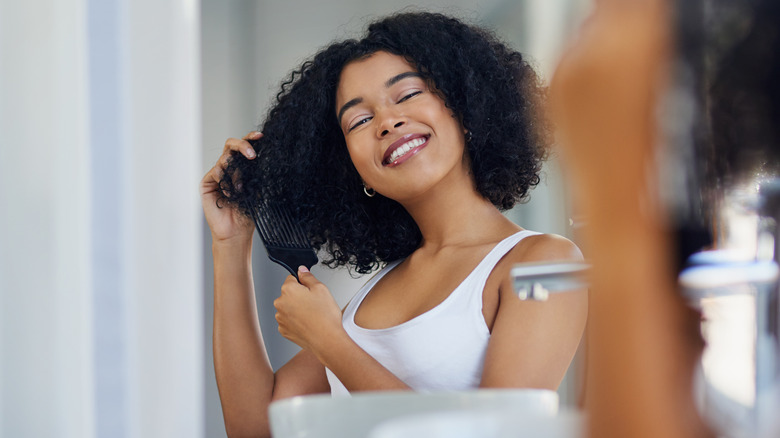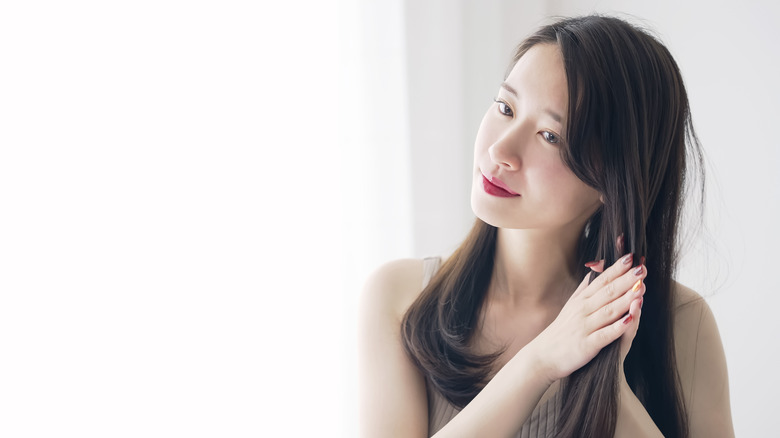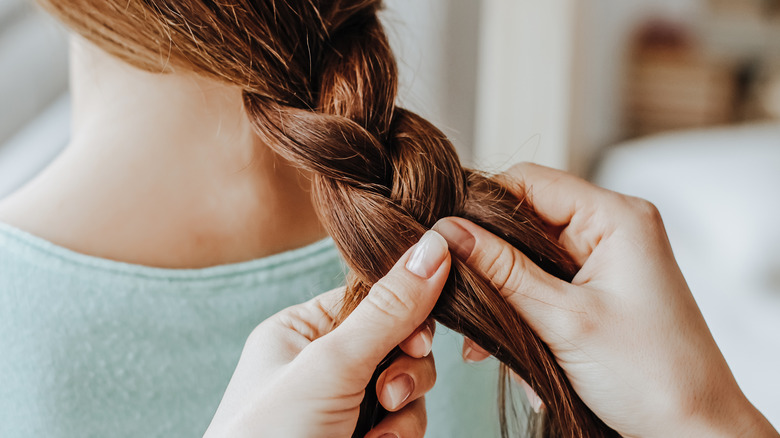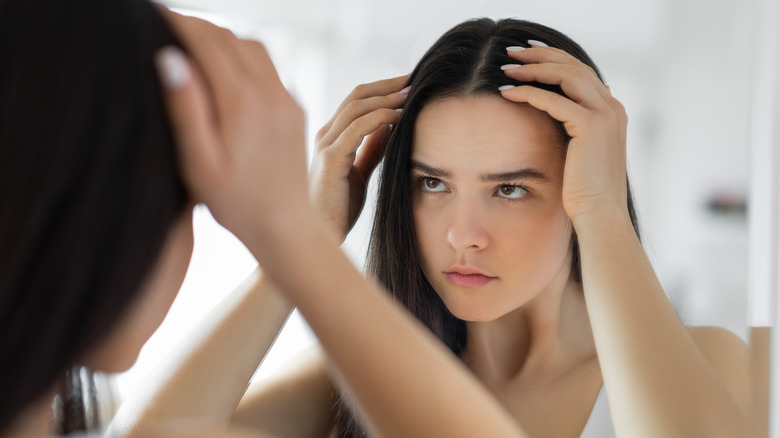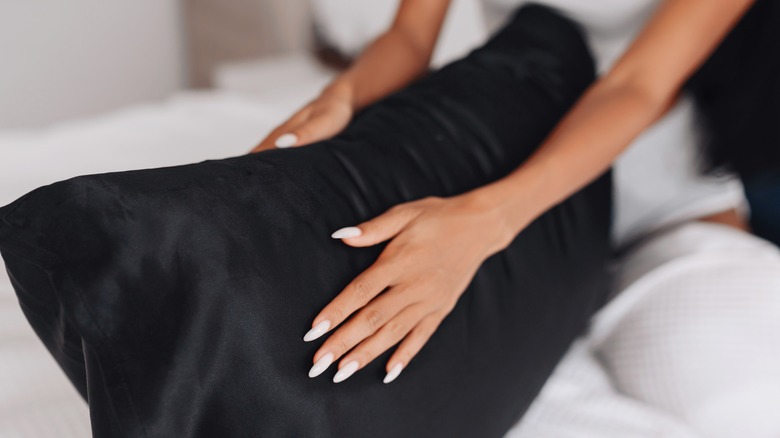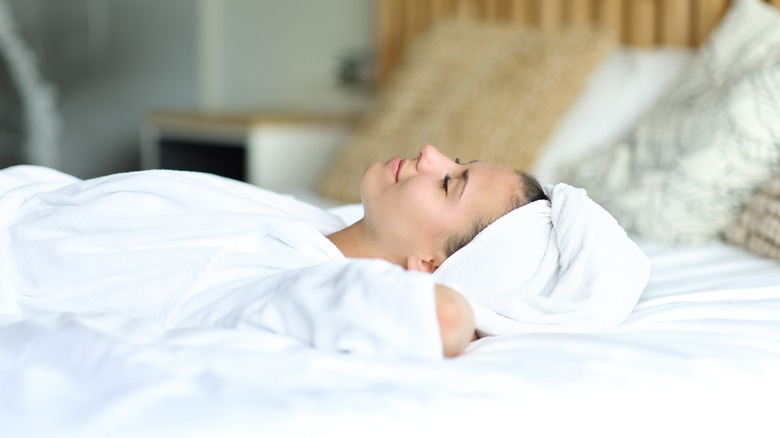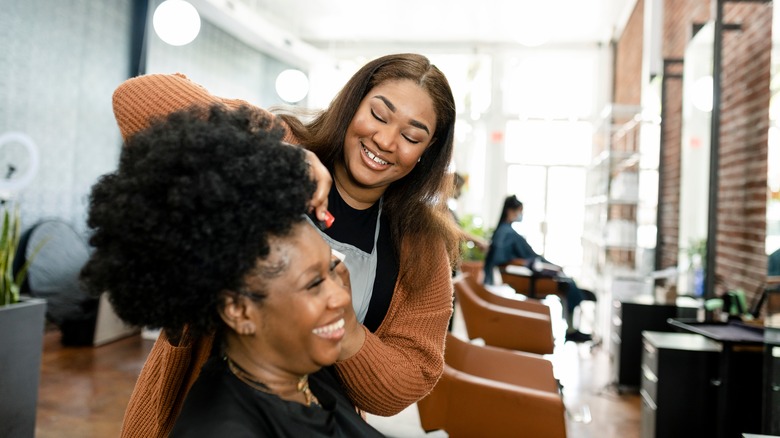How To Banish Frizz When Air Drying Your Hair
Our hair is our crowning glory, and we always want it to look gorgeous. In recent years, there has been a lot of attention on scalp care and focus on shampooing the scalp to keep it healthy since that's where our hair actually grows from. Unfortunately, our hair also experiences damage from exposure to the sun, over-usage of hot tools and hair colors, and our diet, which can sometimes make our hair drier, thinner, and prone to breakage (via Medical News Today).
The power of a good hair day cannot be undermined because when our hair looks good, we feel more confident. Research shared that Americans experience over three months of bad hair days in a year, and most of them prefer to stay in and even skip work if their hair doesn't look great, per the New York Post. Our hair really has the power to make or break our days.
Some people hate humidity because it makes us super sweaty, but it also messes up our hair, making it look extra frizzy — and we can blame the cuticles for that. Steve Waldman, director of technical training at Hair Cuttery Family of Brands, told Healthline, "A healthy cuticle lays down smooth," resulting in a smoother appearance. However, when hair is "dry and damaged, its appearance resembles a pine cone: open, rough and prickly." While we can take proactive steps to keep the hair healthy, how we dry our hair can also help tone down the frizz.
Brush and apply oil to your hair before you shower
This might seem odd at first, but preventing after-shower frizz actually starts before you shower. A way to banish frizz when air drying your hair is by applying a small amount of oil to your hair before showering, ideally leaving it on for at least 15 minutes before you wet your hair. Argan oil, coconut oil, or jojoba oil are excellent choices as they provide nourishment and hydration — but make sure you don't confuse a hair oil with a hair serum.
Take a few drops of your preferred oil in your palms and run your fingers through your hair, focusing on the mid-lengths and ends. Applying oil to your hair before showering allows the oil to penetrate your hair cuticles, creating a protective barrier. This pre-wash treatment prevents your hair from absorbing too much water, which can lead to swelling and frizz.
The oil acts as a shield, protecting your strands from excess moisture, humidity, and even heat. After applying the oil, proceed with your regular shampoo and conditioning routine. You'll notice that your hair feels smoother, more manageable, and less prone to frizz when air drying. Incorporating this simple step into your hair care routine can make a significant difference when it comes to achieving smooth and shiny air-dried hair.
Hydrate your hair in the shower
Picking the right hair products for your shower routine is essential when it comes to fighting frizz and keeping your hair healthy and moisturized. A lot of shampoos and conditioners on the market contain ingredients that can over-strip your hair of its natural oils (which are actually essential to your hair's health), leaving it very dry and frizzy. That's why you should be mindful of the products you choose and opt for ones that provide hydration and nourishment.
When selecting a shampoo, look for ingredients such as glycerin, which helps to attract and retain moisture in the hair. Avoid shampoos that contain sulfates, as they can be overly drying. Conditioners are equally important in your shower routine. Choose a conditioner that is rich in moisturizing ingredients like shea butter or argan oil. These ingredients help to hydrate and soften your hair, reducing frizz and promoting smoothness.
Keep in mind that everyone's hair is different, so finding the right products may require some trial and error. Pay attention to how your hair responds to different formulas, and know that switching up your shampoo routine is totally okay. By prioritizing hydration in the shower and finding the right balance for your hair, your frizz-free journey will be so much easier.
Wash your hair with lukewarm and rinse with cold water
The temperature of the water you use when washing and rinsing your hair plays a significant role in maintaining healthy locks and minimizing frizz. To make sure your hair continues being healthy, start washing it with lukewarm water. While hot water may feel relaxing, it can actually strip away your hair's natural oils, leaving it very dry and prone to a lot of frizziness. Lukewarm water helps retain moisture and keeps your hair's cuticles smooth.
Once you've finished washing and conditioning, it's time to give your hair one final rinse. Here's where cold water comes into play. Cold water helps seal the hair cuticles, meaning that any benefits of a conditioner or hair mask will be locked in better. While it may feel chilly, the results are definitely worth it.
If you find it challenging to tolerate cold water, you can start with lukewarm water and gradually lower the temperature as you rinse. Over time, rinsing with cold water will not only benefit your hair, but it will eventually begin to feel relaxing due to its impact on the vagus nerve. Yes, cold showers actually have amazing benefits for our mental health.
Regularly apply hair masks
Don't underestimate how much of a difference that extra dose of moisture can make. Hair masks are a fantastic way to provide intense hydration and nourishment, which — as we already established — is crucial in helping to prevent frizz when air drying. Depending on the condition of your hair, you may choose to use a hair mask two to three times per week. Look for hair masks that are specifically formulated to target frizz and dryness, which provide deep conditioning and replenishment.
With a variety of hair masks available on the market, it may take some time to find the one that works perfectly for you. Pay attention to your hair's needs and experiment with different formulas to discover the best fit. Consider factors such as your hair type, level of damage, and desired results. Since each mask tends to be different, make sure you carefully follow its instructions to ensure the best results.
And while you might expect a miracle, be aware that just like all hair products, masks also need time — meaning that one or two applications won't give you a drastic change. However, over time, regular use of hair masks can help restore your hair's moisture balance, reduce frizz, and improve its overall health.
Use microfiber towels or old T-shirts to dry hair
When it comes to drying your hair after showering, the type of towel you use makes a significant difference. Instead of reaching for a regular bath towel, consider using a microfiber towel or an old T-shirt, as those will help minimize frizz. Microfiber towels are very gentle on the hair and help absorb excess moisture without roughing up the hair cuticles, which is what often leads to frizz. The smooth texture of microfiber towels also reduces friction and helps maintain your hair's natural texture, resulting in smoother and less frizzy strands.
If you don't have a microfiber towel on hand, an old cotton tee can be a great alternative. They also absorb moisture effectively without causing as much friction and frizz as regular towels. However, no matter what you end up using to dry your hair, your technique also impacts the levels of frizziness you'll end up with. For best results, wrap the towel or T-shirt around your head, allowing it to absorb the moisture, and avoid rubbing or vigorously towel-drying your hair.
Skip the brush and use a comb instead (or use a brush with boar bristles)
When it comes to detangling and styling your hair while it air dries, it's best to skip the traditional brush and opt for a wide-tooth comb, as it's much gentler on your hair and can help minimize frizz. Ideally, you should skip the brushing altogether while the hair is wet. But if necessary, using a wide-tooth comb or a detangling comb allows you to gently work through any knots or tangles in your hair without causing excessive breakage or frizz.
Start at the ends of your hair and slowly work your way up to the roots — in the end, you should be able to comb from top to bottom without any knots. This method helps to prevent unnecessary stress on your hair and keeps the hair cuticles intact, resulting in a smoother final result. Once your hair is already dry, we suggest using a brush with boar bristles.
These brushes help distribute the protective oils from your scalp down each hair, providing it with nourishment and added shine. Since the bristles are soft and gentle, there is minimal friction and no added frizziness. Regardless of whether you use a wide-tooth comb or a brush with boar bristles, it's essential to always be gentle when styling your hair — especially when it's still wet. Avoid excessive pulling or tugging, as this can lead to additional frizziness.
Always apply leave-in conditioner or serum
If you're prone to frizziness, post-shower hair moisturizing products are your BFF. To fight frizz while air drying, always add a leave-in conditioner or serum to your hair. These products provide an extra layer of hydration and help seal the hair cuticles, resulting in more manageable hair.
After washing and towel-drying your hair with a microfiber towel or T-shirt, take a small amount of leave-in conditioner or hair serum, and start by applying it to the middle and ends of your hair, focusing on the areas that tend to be drier or more prone to frizz.
Gently work the product through your hair, ensuring even distribution. A little usually goes a long way with these products, so start with a small amount and add more if needed. Too much product can quickly lead to buildup and weigh your hair down, which you certainly want to avoid.
Consider braiding your hair for a heatless wave
Effortless waves without using any heat can easily be achieved by braiding your hair. Not only does this technique create a beautiful pattern in your hair, but it also allows you to embrace a slightly messy and natural look, frizz included.
To begin, start with slightly damp hair, as this will help minimize any frizz at the end. Divide your hair into sections and braid each section loosely. You can opt for one or multiple braids depending on how thick and long your hair is, as well as what kind of waves you prefer.
Secure the ends of the braids and leave them in place for several hours or overnight to allow the waves to set. The longer you keep the braids, the more defined the waves will be. If you still find that your hair tends to frizz excessively, you can apply a small amount of anti-frizz serum or hair oil to tame any flyaways.
Keep your hands off your hair
One of the simplest yet often overlooked tips for minimizing frizz when air drying your hair is to resist touching or running your fingers through your hair. While playing with your hair or fixing any out-of-place strands may be tempting, constant touching can contribute to frizz.
Touching your hair frequently can disrupt its moisture balance, leading to increased frizz and flyaways. Additionally, the friction caused by running your fingers through your hair can harm the hair cuticles, resulting in a rougher, more frizz-prone texture. It's best to keep your hands off your hair as much as possible to prevent this.
If you find it difficult to resist touching your hair, consider styling it to keep it off your face and out of reach. This could be achieved by using hair clips, headbands, or scrunchies to hold your hair back. However, ensure that the hairstyle isn't tight as you want to only gently move the wet hair out of your face without causing any damage.
Use a silk pillowcase or bonnet
Switching to a silk pillowcase or using a silk bonnet while you sleep is healthy for everyone's hair — regardless of whether it's frizzy or not. "The benefit of having a good silk pillowcase is that it creates less friction on the hair and allows the hair a gentle surface," Hairstylist Bobby Eliot tells Today. "Friction can disrupt the cuticle layer of the hair, which causes bedhead and frizzy hair."
Of course, not everyone may be able to invest in an actual silk pillowcase or bonnet, so the second best option is going for satin. Both silk and satin have the same smooth surface that reduces friction. However, silk is more breathable, making it the better (and boujier) option.
Regardless of what you opt for, you will notice an immediate difference in your hair's shine and frizz levels. And if you're unsure whether to pick a pillowcase or bonnet, we recommend going for the pillowcase, as silk and satin are also super gentle on the skin of your face.
Don't go to sleep with wet hair
While it may be tempting to hop into bed with wet hair after a relaxing shower, it's best to avoid this habit if you want to wake up with frizz-free hair. Going to sleep with wet hair not only leads to increased frizz but also potential damage to your strands.
When your hair is wet, it is more likely to break. The friction between your hair and the pillowcase can cause the hair cuticles to become damaged, resulting in a frizzy texture. Additionally, tossing and turning can cause your wet hair to tangle, which will be rather annoying to deal with in the morning.
To prevent all of this, make sure your hair is at least partially dry before going to bed. This means that if you prefer to air dry your hair, give yourself enough time before bedtime to allow your hair to dry naturally. If you must sleep with slightly damp hair, consider using a microfiber towel or a soft T-shirt to wrap your hair, as this can help keep it in place and minimize friction.
See your stylist for regular trims
If you notice that none of these tips are helping much, it might be time to see your hairstylist. Excessive frizz can sometimes be a sign of split ends and damaged hair that is in need of a fresh cut. If you're growing your hair out and you notice that it has suddenly become very prone to frizz and difficult to manage, it may be time for a trim.
Getting rid of the damaged ends will promote healthier hair growth and reduce frizz — which makes it beneficial to hair growth in the long run. Your stylist will examine your hair and determine the amount that should be trimmed.
Even if your hair isn't too frizzy, going to your stylist for regular trims means that you are taking proactive steps to maintain healthy and frizz-free hair. So, make it a priority to schedule regular appointments to ensure that your locks are always in the best possible condition.
